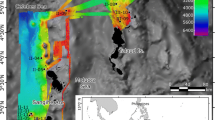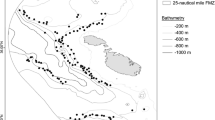Abstract
Cephalopods are important members of deep-sea communities. However, the preference of many incirrate octopods for rocky substrate makes them largely unavailable with traditional sampling methods such as trawls. Therefore, much remains to be discovered about their diversity. This study focuses on the diversity and distribution of bathyal incirrate species in the western North Atlantic. We used observations from remotely operated vehicle (ROVs) videos, augmented by museum specimens and records from the Ocean Biogeographic Information System (OBIS), to compile a summary of the diversity of bathyal incirrates in the study area and their general distribution. In 22,861 approximately 5-min ROV video clips, we counted 2017 unique incirrate octopod individuals representing at least seven different species. Across observation types, the most common species we recorded were Bathypolypus bairdii Verrill, 1873, Graneledone verrucosa Verrill 1881, Muusoctopus spp., Scaeurgus unicirrhus Delle Chiaje in Ferussac & Orbigny, 1841, Pteroctopus tetracirrhus Delle Chiaje, 1830, and Tetracheledone spinicirrus Voss, 1955.





Similar content being viewed by others
References
Collins MA, Yau C, Allcock L, Thurston MH (2001) Distribution of deep-water benthic and bentho-pelagic cephalopods from the north-east Atlantic. J Mar Biol Assoc UK 81:105–117
Eakins B, Gottfried S, Murphy P, Lovalo D, Sowers D (2019) It takes a village! Managing data from Okeanos Explorer. Oceanography 32:106–109
Gleadall IG (2013) A molecular sequence proxy for Muusoctopus januarii and calibration of recent divergence among a group of mesobenthic octopuses. J Exp Mar Biol Ecol 447:106–122
Hartwell AM, Voigt JR, Wheat CG (2018) Clusters of deep-sea egg-brooding octopods associated with warm fluid discharge: an ill-fated fragment of a larger, discrete population? Deep-Sea Res 135:1–8
Jereb P, Roper CFE, Norman MD (2016) Cephalopods of the World: an annotated and illustrated catalogue of cephalopods species known to date. Vol 3: Octopods and vampire squids, 4th edn. Food and Agriculture Organization of the United Nations, Rome
Judkins HL (2009) Cephalopods of the Broad Caribbean: distribution, abundance, and ecological importance. Dissertation, University of South Florida.
Kayes RJ (1974) The daily activity pattern of Octopus vulgaris in a natural habitat. Mar Behav Physiol 2(1-4):337–343
Luo JY, Irisson JO, Graham B, Guigand C, Sarafraz A, Mader C, Cowen RK (2018) Automated plankton image analysis using convolutional neural networks. Limnol Oceanogr-Meth 16:814–827
Macreadie PI, McLean DL, Thomson PG, Partridge JC, Jones DOB, Gates AR, Benfield MC, Collin SP, Booth DJ, Smith LL, Techera E, Skropeta D, Horton T, Pattiaratchi C, Bond T, Fowler AM (2018) Eyes in the sea: unlocking the mysteries of the ocean using industrial, remotely operated vehicles (ROVs). Sci Total Environ 634:1077–1091
Muus B (2002) The Bathypolypus-Benthoctopus problem of the North Atlantic (Octopodidae, Cephalopoda). Malacologia 44:175–222
Norman MD (2016) General remarks on octopods. In: Jereb P, Roper CFE, Norman MD. Cephalopods of the world: an annotated and illustrated catalogue of cephalopods species known to date. Vol 3: Octopods and vampire squids. 4 Ed. Rome: Food and Agriculture Organization of the United Nations
Pappalardo P, Pringle JM, Wares JP, Byers JE (2015) The location, strength, and mechanisms behind marine biogeographic boundaries of the east coast of North America. Ecography 38:722–731
Pickart RS, Watts DR (1990) Deep Western Boundary Current variability at Cape Hatteras. J Mar Res 48:765–791
Purser A, Marcon Y, Hoving HJT, Vecchione M, Piatkowski U, Eason D, Bluhm H, Boetius A (2016) Association of deep-sea incirrate octopods with manganese crusts and nodule fields in the Pacific Ocean. Curr Biol 26:R1268–R1269
Robison B, Seibel B, Drazen J (2014) Deep-sea octopus (Graneledone boreopacifica) conducts the longest-known egg-brooding period of any animal. PLoS One 9:7–10
Roeleveld MA, Lipiński MR, Augustyn CJ, Stewart BA (1992) The distribution and abundance of cephalopods on the continental slope of the eastern South Atlantic. S Afr J Mar Sci 12:739–752
Rosa R, Dierssen HM, Gonzalez L, Seibel BA (2008) Large-scale diversity patterns of cephalopods in the Atlantic open ocean and deep sea. Ecology 89:3449–3461
Shea EK, Judkins H, Staudinger MD, Dimkovikj VH, Lindgren A, Vecchione M (2017) Cephalopod biodiversity in the vicinity of Bear Seamount, western North Atlantic based on exploratory trawling from 2000 to 2014. Mar Biodivers 47:699–722
Vecchione M (2001) Cephalopods of the continental slope east of the United States. Am Fish So S 153–160.
Vecchione M, Young RE, Piatkowski U (2010) Cephalopods of the northern Mid-Atlantic Ridge. Mar Biol Res 6:25–52
Acknowledgements
The first author would like to thank the other members of the France lab at UL Lafayette: L Walling, J Awbrey, and U Ganguly, for ideas and troubleshooting, and Dr. Kelly Robinson (UL Lafayette) for help with the confusion matrix. The Invertebrate Zoology Department at the Smithsonian Institution’s National Museum of Natural History and Nancy Voss (recently deceased) at the University of Miami Marine Invertebrate Museum allowed access to their respective collections. This study would not have been possible without the NOAA Okeanos Explorer program and the National Centers for Environmental Information. We would like to thank the reviewers for their input.
Funding
No funding was required for this study as it used already available data.
Author information
Authors and Affiliations
Corresponding author
Ethics declarations
Conflict of interest
The authors declare no competing interests.
Ethics approval
No animal testing was performed during this study.
Sampling and field studies
The study does not contain sampling material or data from any new field studies.
Data availability
The datasets analyzed during the current study are available in the NOAA Okeanos Explorer Video Portal (https://www.nodc.noaa.gov/oer/video/), museum collections at the Museum of Comparative Zoology (https://mczbase.mcz.harvard.edu/SpecimenSearch.cfm), National Museum of Natural History (https://collections.nmnh.si.edu/search/iz/), Yale Peabody Museum (https://collections.peabody.yale.edu/search/), and University of Miami Invertebrate Collections (no online search), and the Ocean Biogeographic Information System (https://obis.org/).
Author contributions
This study was undertaken as a chapter for the first author’s master’s thesis. The second and third authors were the first author’s advisors. All the authors contributed to the study conception and design. Material preparation, data collection, and analysis were performed by Abigail Pratt. The first draft of the manuscript was written by Abigail Pratt and all the authors commented on following versions of the manuscript. All the authors read and approved the final manuscript.
Additional information
Communicated by K. Kocot
Publisher’s note
Springer Nature remains neutral with regard to jurisdictional claims in published maps and institutional affiliations.
Rights and permissions
About this article
Cite this article
Pratt, A., France, S.C. & Vecchione, M. Survey of bathyal incirrate octopods in the western North Atlantic. Mar. Biodivers. 51, 49 (2021). https://doi.org/10.1007/s12526-021-01191-y
Received:
Revised:
Accepted:
Published:
DOI: https://doi.org/10.1007/s12526-021-01191-y




